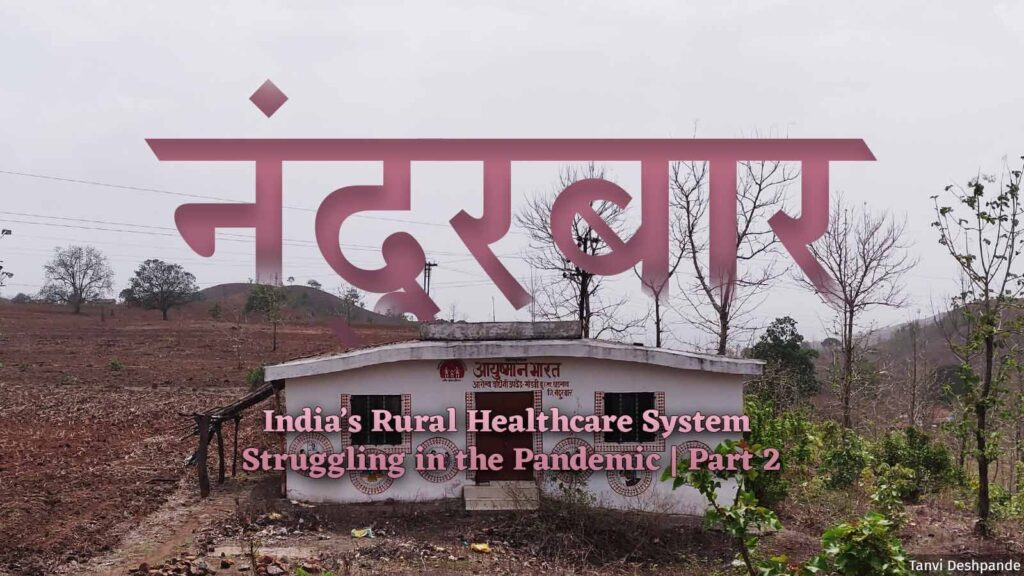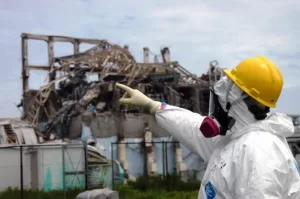Nandurbar: When Kalubai Valvi was bitten by a snake last monsoon in Sumbipada in Nandurbar district of Maharashtra, her husband Nimji did not take her to the primary health centre (PHC) in neighbouring Jangthi village. Instead, he paid more than Rs 2,000 to hire a vehicle to take her to the government-run Molgi rural hospital, two hours away. Valvi did the same when his daughter was bitten by a snake a few months later. Both survived.
Kalubai fears for the safety of her six children during monsoon months when snakebites are common in rural Nandurbar. “Let’s see what happens this year,” said Kalubai nervously as the family sat watching a solar-powered television set.
There is a reason why Nimji did not rush his wife or daughter to the Jangthi PHC. “There are no facilities there and there is no staff at night,” said Nimji, a farmer with seven family members to care for and few resources to afford medical bills. The older Jangthi PHC was housed in a decrepit building and it was moved to a newer building in June 2021. But with no water or electricity, the centre is barely functional.
As the pandemic’s second wave peaked in May 2021, 53% of the deaths caused by Covid-19 were in rural India, said a report by the Centre for Science and Environment which pointed to the acute shortage of resources crippling community health centres. With a potential third wave now looming, we visited the remote tribal district of Nandurbar in northern Maharashtra to understand the challenges of rural healthcare.
We are reporting our findings in a two-part series, the first of which detailed how unprepared Nandurbar’s rural healthcare system is to deal with Covid-19 with expired medicines in PHC pharmacies, including injections for adverse reactions to vaccines. In this concluding part of the series, we report how these facilities are not even equipped to deal with routine emergencies.
No testing facilities
A snakebite can be even more fatal for a resident of Mandvi village in the Nandurbar district’s Akrani taluka. Snakebite patients are referred by the PHC there to the Dhadgaon rural hospital, 10 km away, or to the Nandurbar civil hospital, 60 km away.
Nandurbar in northern Maharashtra is a backward, predominantly tribal, district described as aspirational, by government think-tank NITI Aayog. It had also reported one of the highest case fatality rates in the state in the second wave of the Covid-19 pandemic. The state itself had been among the worst-hit in India.
With basic needs unmet, rural Nandurbar relies mostly on quacks and private practitioners, we found. Snakebites are only one of its problems. We also found that most women in the district’s villages had not had institutional deliveries before or during the pandemic. They mostly deliver at home without professional care because of the problems of accessing local healthcare.
As for Covid-19 emergencies, many PHCs did not even have rapid testing facilities, let alone RT-PCR, ahead of a possible third wave. While the district administration had erected Covid Care Centres during the earlier phases of the pandemic, many are now shut which means a Covid-19 patient will have to be taken to the taluka’s rural hospital for oxygen availability. But patient transportation, as we see later, is an ordeal because PHC ambulances are unreliable and rural roads are a mess.
“The average walking distance to a PHC [in India] for most people is 8 km and many times this 8 km is in hilly areas. We have just 24,000 PHCs across the country, when we need around 125,000 more and the state of these PHCs is a joke–they are ill-equipped, ill-staffed,” said Abhijit Vaidya, national president of Pune-based Arogya Sena that works in the field of public health. He pointed out that with a health allocation of just 1.1% of the national gross domestic product (GDP), it is not surprising that India fares worse than Bangladesh on rural healthcare. The World Health Organization suggests a health budget allocation of 5% of the national GDP, he added.
Operating guidelines unheeded
According to Indian Public Health Standards (IPHS), PHCs are supposed to provide outpatient services, 24-hour emergency services, referral services and in-patient services. The IPHS guidelines for PHCs list 24-hour delivery services, both normal and assisted, as essential services. This includes promotion of institutional deliveries and management of normal deliveries. Institutional deliveries are important to reduce infant and maternal mortality.
Also, after the outbreak of the pandemic, a Standard Operating Procedure was issued by the Ministry of Health and Family Welfare for the continuation of essential services. It stated that PHC teams are supposed to follow up with pregnant women, high-risk pregnant women, newborns, children due for immunisation and malnourished children on their needs. The SOP also stated that each pregnant woman is to be linked to an appropriate facility for delivery and in case of home deliveries, immediate visits are to be made by Auxiliary Nurse Midwife (ANM) or Community Health Officers (CHO) to assess the health of the woman and newborn.
We found that these guidelines were not followed.
Rural health centres are also having a tough time with the Covid-19 vaccination drive. Poor power supply (for vaccine cold storage) and internet connectivity (for Cowin registration) are major stumbling blocks, as we explain later. Coupled with vaccine hesitancy, the pace of vaccination in rural Nandurbar has slowed down.
The district has vaccinated 40.7% of those above 45 with at least one dose of the vaccine as on July 28 while 15 other districts in the state have done better on this front. Kolhapur leads the state with 74.28% vaccination.
Home deliveries preferred
Jangthi in Akkalkuwa taluka is one of the most remote villages in the district and while electric poles have been erected in the area, there is no power supply. The barely furnished new PHC building does not have water supply either which means that it is not equipped to conduct deliveries. Most women who live around this PHC choose to deliver at home, as we said. A visit to Sumbipada which is covered by this PHC showed that healthcare workers have been missing from work for a while now.
Gulbi Gamer Singh of Sumbipada has two daughters, one four-year-old and another, six months old, and she has not had any visits from ASHAs (accredited social health activists) asking about immunisation or nutrition for her children. “They still haven’t seen my children. Both deliveries happened at home. I wasn’t given any supplements, did not receive any money (paid as part of Janani Suraksha Yojana for home births). I went and got my children vaccinated at health camps. My children have not received any nutritious food from the anganwadi in two months,” said Gulbi, cradling her baby.
Even Kalubai’s six children were delivered at home. They did not receive any routine immunisation except for polio.
The situation was the same in three of the five PHCs we visited.
Pisibai Kalusingh Vasave was waiting outside Mandvi PHC in Nandurbar’s Akrani taluka for her Covid-19 jab. A resident of the same village, Pisibai has five children, all of whom were delivered at home. “But the nurse helped us,” said Vasave, alarmed when asked why she did not choose to deliver at a health facility. At the neighbouring Telkhedi PHC, the staff told us the outpatient department nurse can handle deliveries during the day but she is not available at night.
Waiting an entire morning for a doctor
At the newly inaugurated Bilgaon PHC, the staff complained of no power supply or internet connectivity that hampers their services, particularly vaccination and deliveries. The designated ambulance for this PHC had broken down for around six months in 2020. It is now available but those living in deep interiors still need to get patients to a decent road on a bamboo carrier. Bilgaon PHC caters to 11 villages with a population of 14,221.
In Jangthi too, everyone, from the residents to the staff at its PHC, complained about the condition of the road linking it to Molgi where a dependable rural hospital is situated. The road was sanctioned under the Pradhan Mantri Gram Sadak Yojana, a flagship central mission to build rural roads, but now is no more than a heap of rubble and dust. So, villagers carry patients on a bamboo stretcher upto the spot from where a public or private ambulance can then take them to a hospital. This ordeal worsens during the rains when villagers have to use small dinghies to cross swollen rivers.
“The old ambulance in Jangthi PHC was defunct for almost a year. Even when it was available, they would charge us Rs 1,500. Private vehicles charge Rs 2,000. We don’t have a choice because we have to rush to Molgi rural hospital in case of any emergency at night,” said a resident.
At the end of a long journey, there is no guarantee that a doctor will be available at the PHC.
“Even for routine outpatient consultations, people come and wait at the PHC from 8 a.m. onwards while the doctor never comes before 11 a.m.,” said Batesingh Pavra, a resident of village Mal in Dhadgaon that falls under Bilgaon PHC.
Mogra Khetya Valvi and her father were waiting for a doctor to arrive at the Jangthi PHC when we arrived there. She had been complaining of swelling in her body and exhaustion for almost a month. The staff suspects she is anaemic. Nandurbar reports numerous cases of sickle cell anemia, a genetic disorder. It was 11 a.m. and Mogra and her father had already been waiting for a couple of hours. The doctor finally arrived at 2 p.m. and referred Valvi to the Molgi rural hospital for a simple blood test since the lab technician at Jangthi was not available. Mogra and her father had to stay over in a neighbouring village, submit samples the next morning and later collect reports so they could show it to the doctor the next day.
Acute staff shortage
A look at the muster in Jangthi PHC showed one clerk and two peons had not reported to work since May 2021 while one of the two doctors had not shown up to work between June 10 and June 21. The PHC caters to nine villages or a population of 11,000.
In Shahada taluka, Ratna Bhil, 21, had come to Padalda PHC with her newborn child, husband and mother-in-law. She had delivered her baby only 12 days ago at the civil hospital and had come to the PHC on this June day to get her stitches removed. She had to wait for an hour or so since the doctors were busy. The vacancies at the PHC and the two sub-centres in its campus include nurses (5), general nurse midwife (1), multipurpose health workers (4), lady health visitor or a visiting nurse (1), peons (3) and arogya sahayak or health worker (1).
When IndiaSpend checked in the third week of June, the sub-centre in Malpada village in Akkalkuwa, another in Mandvi and the ones in Padalda were all shut during the day. A sub-centre is the most basic unit of the public health system. It is manned by an ANM and a male health worker. It caters to 5,000 people in the plains and 3,000 in hilly/difficult/tribal areas. (A PHC caters to 30,000 people in the plains and 20,000 in hilly/difficult/tribal areas. Each PHC acts as a referral unit for six sub-centres.)
Latika Rajput, a Nandurbar-based activist and member of the state’s core committee on malnourishment, described these conditions as “inhuman and a violation of the right to life”.
“The unavailability of basic health facilities, no guarantee of a doctor and many such issues at PHCs increase the chances of a referral to the rural hospital. When very critical patients reach the rural hospital, they are further referred to the civil hospital,” she pointed out.
Doctors said they are struggling to deal with shortage of staff and resources. “At night, only the peon and driver are there. I am there only sometimes. Nurses cannot stay overnight as they have no accommodation facilities. An ambulance is available because the driver is a local,” said Santosh Pavra, medical officer of Telkhedi PHC. When asked about missing doctor signatures on some outpatient department (OPD) case papers at the PHC, he admitted: “The lab technician had to run the OPD for one day. I had asked him to. We (doctors) are having vaccination sessions every day. What can we do?”
Basic Covid services missing
According to the SOP released by Union Ministry of Health and Family Welfare’s (MoHFW) on ‘Covid-19 Containment and Management in Peri-Urban, Rural and Tribal areas’, PHCs have been given a long list of responsibilities including the supervision of Covid Care Centres for asymptomatic or mild symptomatic cases, as we said in the first story in the series. They are also supposed to be turned into Dedicated Covid Health Centres (DCHC) for moderate cases and are expected to have oxygen support. But PHCs were barely managing to carry out vaccination.
“Without revitalising the public health system, if the government is thinking about giving it Covid responsibilities, it is a mockery of the people,” said health activist Abhijit Vaidya.
At the Mandvi PHC, we found that rapid testing kits for Covid-19 were not available and villagers would need to go to Dhadgaon to get themselves tested. Covid-19 patients who need oxygen too would need to go to Dhadgaon, contrary to the SOP guidelines.
The PHC offers Covid-19 vaccination but there is no internet service to enter beneficiary details in the COWIN portal which tracks the national immunisation drive so the staff have to travel to Dhadgaon to make the entries. After a slow start, the immunisation drive is picking up at the PHC–we saw 30-50 people queuing up for jabs.
The Telkhedi PHC did not have a rapid testing kit either and sealed vaccine vials were found in a plastic food container in a fridge at the PHC. Doctors said they were helpless in dealing with the chronic staff and resource shortages at their centres.
“Rapid testing kits have not been allotted to us,” said Pavra, medical officer at the Telkhedi PHC.
At Bilgaon, the PHC has managed to vaccinate only 10-12 people a day so far which, the staff claimed, was an improvement over the initial months. Villagers here have to go to Dhadgaon for an RT-PCR test, results of which take at least three to four days. The same is the case if a Covid-19 patient needs oxygen. Rapid testing kits were however available here.
In Jangthi, the PHC staff has been struggling to get people vaccinated. It had only managed 174 vaccinations by the third week of June. A rapid test is now available here. The ice pack for the vaccine has to be brought from Molgi rural hospital since there is no cold storage facility here.
[Tanvi Deshpande is an independent journalist based in Maharashtra. She covers health, gender, environment and COVID-19. Article courtesy: IndiaSpend, a non-profit that utilises open data to inform public understanding on a range of issues, with the aim of fostering better governance and more transparency and accountability in governance.]




